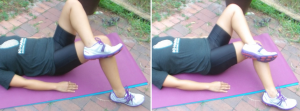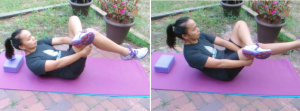The following guest post is from our Best Damn Runner, Karen Gonzalez. You can follow her blog at runcoachk.wordpress.com
“I want to run longer…run faster”- common wish of most runners. To achieve this, proper training including long runs, intervals, aerobic threshold training, strength training and a solid nutritional plan is a necessity. However, one essential part of training has almost become an afterthought for most runners – STRETCHING. Many of us follow the regimen of dynamic stretches before the run and static stretching after running but spend a relatively short amount of time to stretch those muscles.
What is Ki-Hara?
Ki-Hara (“Ki” or “Chi”= energy, “Hara”=pelvic area or core) resistance stretching is an exercise system designed by Steven Sierra and Anne Tierney of Innovative Body Solutions that stretches and strengthens the body dynamically while energizing the core and training the whole body eccentrically & concentrically. Olympic athletes such as Dara Torres attribute her stunning performance in the Beijing Olympics in 2008 to her stringent program and Ki-Hara training with Sierra and Tierney.
How will Ki-Hara improve running and recovery?
Ki-Hara Resistance Stretching is a technique that combines stretching and strengthening of muscle and fascial tissue during eccentric contraction or lengthening of the muscle.
A lot of runners do not stretch because they believe their muscles have a better ability to bounce or rebound during their run, which make them faster and/or stronger. The goal of Ki-Hara is to increase soft tissue range of motion and strengthen throughout the range. This prevents overuse injuries that may occur due the soft tissues’ inability to handle eccentric loading e.g. Achilles Tendinitis which is common for midfoot and forefoot strikers due to the constant stress on the tendon and calf of lowering the body slowly to the ground and immediately pushing off.
The basis of Ki-Hara lies within the basic functions of main contracting muscle, its opposing and stabilizing muscles and how they influence each other’s motion. For a runner to have an effective and strong stride, his muscles have to work in synchrony with each other. Let’s take the quadriceps and hamstrings. If the quadriceps “kick” the lower leg forward before the foot lands, the hamstrings have to lengthen itself with as much force to ease that leg gently to the ground, decreasing the stress on the knees, hips and ankles. Because of this rhythmic partnership, the quadriceps can only contract as much as the hamstrings can relax and lengthen. If there is an imbalance in pull between these opposite muscles, injuries may occur such as a Runner’s knee or a hamstring strain.
So why not try Ki-Hara?
This exercise can be done by the runner himself or with the assistance of another person to get a more effective stretch.
Here are some self-stretches for you to try. If it seems confusing, remember that there is a constant push and pull action.
HAMSTRINGS
Lie on your back with your knees bent. Bring your left knee toward your right shoulder and grab your heel, calf or use a strap. Bend the knee, moving your left heel down toward your glutes. Gently resist the hamstring contraction with your hands as you lengthen your leg toward your right shoulder. Repeat three to six times per leg.
QUADRICEPS
Lie on your back with your right knee bent at 90 degrees or slightly less. Drop your right knee inward and place your left ankle just above your right knee. Using your left leg for resistance, slowly raise your right knee. Next, push the right knee toward the mat while resisting with your left leg. Repeat three to six times per leg.
OUTER THIGH
Lie on your back and cross your left ankle over your right knee. Clasp your hands around the right leg. Push the left leg down against the right thigh, contracting your glutes and the outside of your thigh. This will tend to lift your upper body off the mat. Next, while keeping the pressure of the left leg on the right thigh, slowly lower upper body to the mat. Repeat three to six times per leg.
Benefits of Ki-Hara Training:
- Increases your range of motion and strength at the SAME TIME, giving you that extra push that you need when you require more power in your stride.
- It squeezes out the toxins in your muscle fibers generated after a run which helps you recover faster for your next event
- It improves your posture and overall sense of being as it balances the pull of your muscles if done on a regular basis
Give it a shot and make Ki-Hara a part of your training program! Here’s to the best runner you can be!
About the writer: Karen Meriales-Gonzalez has been practicing physical therapy in Florida, USA for over 20 years and is an avid runner. She is a Certified Level I Track and Field Coach with the USATF and is a Level II Certified Ki-Hara Trainer. Find her at on Facebook @ “Run with Coach K” or read her blog at runcoachk.wordpress.com. Questions can be emailed to kargonfl@yahoo.com.




